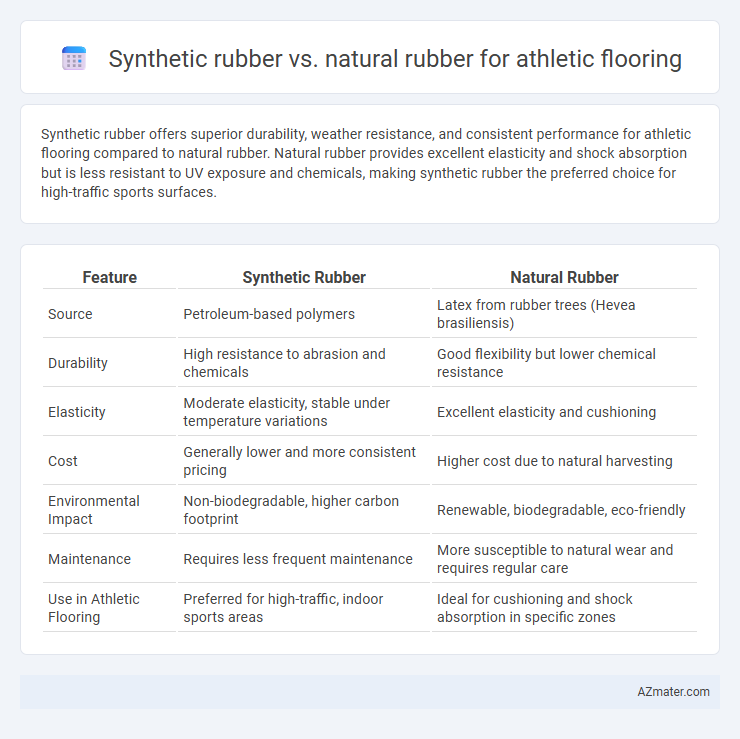Synthetic rubber offers superior durability, weather resistance, and consistent performance for athletic flooring compared to natural rubber. Natural rubber provides excellent elasticity and shock absorption but is less resistant to UV exposure and chemicals, making synthetic rubber the preferred choice for high-traffic sports surfaces.
Table of Comparison
| Feature | Synthetic Rubber | Natural Rubber |
|---|---|---|
| Source | Petroleum-based polymers | Latex from rubber trees (Hevea brasiliensis) |
| Durability | High resistance to abrasion and chemicals | Good flexibility but lower chemical resistance |
| Elasticity | Moderate elasticity, stable under temperature variations | Excellent elasticity and cushioning |
| Cost | Generally lower and more consistent pricing | Higher cost due to natural harvesting |
| Environmental Impact | Non-biodegradable, higher carbon footprint | Renewable, biodegradable, eco-friendly |
| Maintenance | Requires less frequent maintenance | More susceptible to natural wear and requires regular care |
| Use in Athletic Flooring | Preferred for high-traffic, indoor sports areas | Ideal for cushioning and shock absorption in specific zones |
Introduction to Rubber Flooring in Athletics
Rubber flooring in athletics primarily uses synthetic and natural rubber, each offering unique performance benefits. Synthetic rubber provides superior durability, resistance to wear, and consistent shock absorption essential for high-impact sports environments. Natural rubber flooring is favored for its eco-friendly properties, excellent elasticity, and natural grip, contributing to athlete safety and comfort during intense physical activity.
Composition and Properties of Synthetic Rubber
Synthetic rubber used in athletic flooring primarily consists of polymers such as styrene-butadiene rubber (SBR) and ethylene-propylene-diene monomer (EPDM), which are engineered for enhanced durability and resilience. These polymers exhibit superior abrasion resistance, consistent elasticity, and improved weather and chemical resistance compared to natural rubber, making them ideal for high-traffic sports environments. The controlled composition allows for customization of hardness, cushioning, and slip resistance, optimizing performance and safety on athletic surfaces.
Composition and Properties of Natural Rubber
Natural rubber, derived from the latex sap of the Hevea brasiliensis tree, primarily consists of polyisoprene, which provides exceptional elasticity and resilience ideal for athletic flooring. Its high tensile strength, excellent abrasion resistance, and natural cushioning contribute to superior shock absorption and comfort during sports activities. Unlike synthetic rubber, natural rubber also offers better grip and flexibility, enhancing overall durability and performance in high-impact athletic environments.
Durability: Synthetic vs Natural Rubber
Synthetic rubber offers superior durability for athletic flooring due to its resistance to wear, abrasion, and environmental factors such as UV exposure and moisture. Natural rubber, while providing excellent elasticity and shock absorption, tends to degrade faster over time when exposed to heavy traffic and outdoor conditions. Choosing synthetic rubber ensures longer-lasting performance and reduced maintenance costs in high-traffic athletic environments.
Performance and Shock Absorption Comparison
Synthetic rubber outperforms natural rubber in athletic flooring by offering superior durability and consistent performance under varying environmental conditions. Its enhanced shock absorption properties reduce impact forces, minimizing athlete fatigue and injury risk during high-intensity activities. Natural rubber, while providing excellent elasticity, tends to degrade faster and absorbs less shock, making it less suitable for long-term athletic applications.
Environmental Impact and Sustainability
Synthetic rubber, derived from petrochemicals, has a higher carbon footprint and contributes to non-renewable resource depletion, raising concerns about its environmental impact in athletic flooring. Natural rubber, harvested from rubber trees, offers biodegradability and renewability, reducing waste and promoting sustainability. However, sustainable sourcing of natural rubber is crucial to prevent deforestation and biodiversity loss, balancing environmental benefits with ecological preservation.
Cost Factors: Synthetic vs Natural Rubber
Synthetic rubber for athletic flooring generally incurs higher upfront costs compared to natural rubber due to complex manufacturing processes and use of petrochemical resources. Natural rubber offers cost advantages with its renewable sourcing and simpler processing, leading to lower raw material expenses. Maintenance expenses for synthetic rubber may be elevated over time because of additional chemical treatments required to preserve durability and performance.
Maintenance and Longevity Considerations
Synthetic rubber athletic flooring requires less frequent maintenance due to its resistance to moisture, UV rays, and wear, significantly extending its lifespan compared to natural rubber. Natural rubber, while offering superior shock absorption and eco-friendly benefits, demands more regular cleaning and conditioning to prevent cracking and degradation from environmental exposure. Choosing synthetic rubber can reduce long-term upkeep costs and ensure consistent performance in high-traffic athletic facilities.
Health and Safety: Allergies and Chemicals
Synthetic rubber used in athletic flooring minimizes allergy risks, as it is hypoallergenic and free from natural proteins that trigger reactions common with natural rubber. Its formulation often reduces exposure to volatile organic compounds (VOCs) and harmful chemicals compared to natural rubber, enhancing indoor air quality and athlete safety. Compliance with health standards and certifications further certifies synthetic rubber's advantage in creating a safer environment for athletic facilities.
Choosing the Best Rubber Flooring for Athletic Spaces
Synthetic rubber offers superior durability, consistent performance, and resistance to abrasion, making it ideal for high-traffic athletic flooring where resilience and longevity are critical. Natural rubber provides excellent shock absorption and eco-friendly properties but may wear faster under intense gym use and requires more maintenance. Selecting the best rubber flooring for athletic spaces depends on balancing factors like impact resistance, slip prevention, and maintenance demands to ensure safety and performance.

Infographic: Synthetic rubber vs Natural rubber for Athletic flooring
 azmater.com
azmater.com